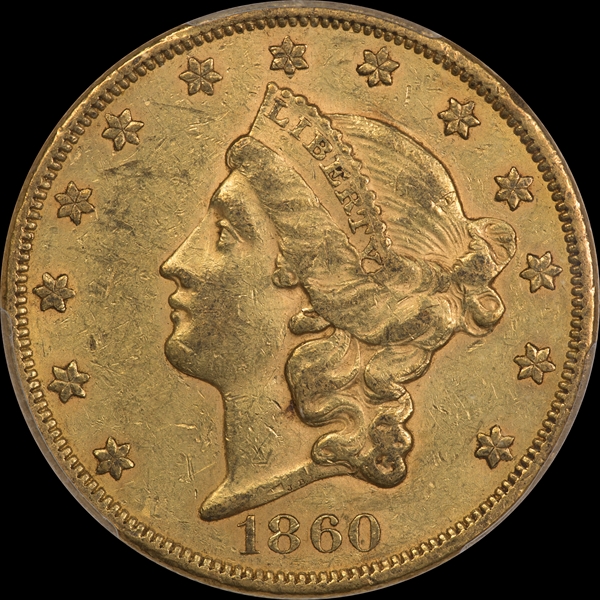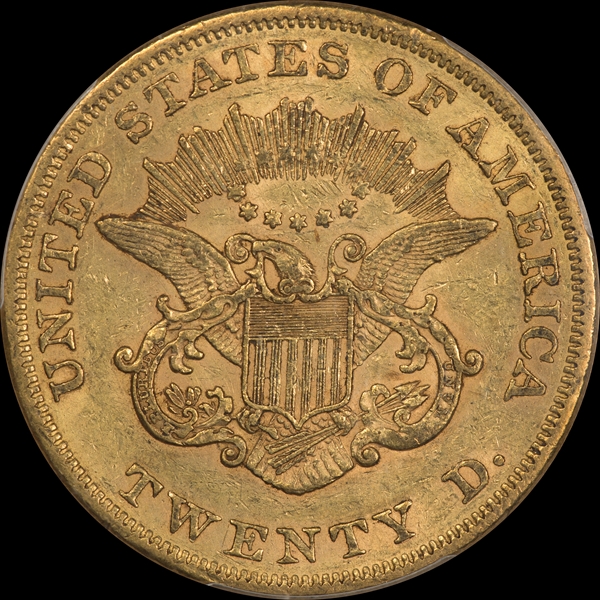1860 $20 AU55 认证号32939989, PCGS号8929
拥有者评论
CAC
专家评论
Doug Winter
The following information is from my eBook on Type One Liberty Head Double Eagles at http://doubleeaglebook.com/The 1860 is the second most available Type One double eagle from the Philadelphia mint produced during the 1860’s.
STRIKE: The quality of strike seen on this date varies. There are a number that are reasonably well-detailed, including good definition on the hair of Liberty. Others show weakness on the hair surrounding the face and below the ear. Even on the sharply-struck coins, the hair at the top of the head will show weakness. The reverse is almost always better struck with sharpness at the center and the border. The wing tips and the tail feathers, as usual, have minor weakness. Some 1860 double eagles were struck from lightly clashed dies with faint obverse clashmarks visible in back of Liberty’s head. There are sometimes fine die cracks seen through the lettering on the reverse.
SURFACES: The 1860 double eagle is not a hard issue to locate with acceptable surfaces. The majority have significant abrasions, but there are enough reasonably clean pieces that the fussy collector should be able to locate the right coin without a massive effort.
LUSTER: This issue has better than average luster. Higher grade pieces have soft, frosty luster which can be very attractive. The quality of luster, along with the 1861, is among the best seen on any Type One double eagle from the Philadelphia mint.
COLORATION: The natural coloration ranges from medium yellow-gold to rose-gold to a medium green-gold hue. There are still a fair number of 1860 double eagles which have natural color, but these are becoming more difficult to locate with each passing year.
EYE APPEAL: The 1860 double eagle has above-average eye appeal. While some are not as sharply struck as one might hope for, there are a decent number which have acceptable surfaces, good luster and nice coloration.
INTERESTING VARIETIES: The unique pattern 1860 double eagle struck in gold (Judd-272a), has the same reverse as found on the 1861 Paquet issues.
PROOFS: 59 Proofs are reported to have been struck. Most of these were melted. Estimates of survivors range from a low of 7 to 9 to a high of 10 to 13; I believe that the correct number is around 9 or 10 coins, and this includes three coins currently in museum collections (ANS, ANA, and Smithsonian). As rare a date as the 1860 is, it is the only pre-Civil War Proof double eagle which most collectors will ever have a chance to own.
As of the middle of 2014, PCGS had graded two in PR63CAM, one in PR64, and two in PR64CAM for a total of 5 Proofs. NGC had graded one in PR64, six in PR64CAM, one in PR65 Ultra Cameo, and one in PR66CAM for a total of 9 Proofs. These figures are significantly inflated by resubmissions, especially in PR64CAM.
The auction record for Proofs of this date is currently $367,188 which was set by an NGC PR66CAM which was sold as Heritage 2014 ANA: 5741. In the Heritage catalog, it is incorrectly pedigreed as being ex Garrett 2: 789. It is, in fact, ex Heritage 1/11: 5276 ($230,000; as NGC PR64) and it was subsequently dipped and regraded.
HOARDS: There were a total of 82 in the S.S. Republic including 43 in Uncirculated.
BUYING TIPS: This date is still relatively available in higher grades (MS60 and above), and attractive coins are still available. This means that the fussy collector can afford to be picky when it comes to this date.
AUCTION RECORD: The auction record for a business strike of this date is $69,000, which was set by Heritage 9/06: 4046, ex S. S. Republic. The coin was graded MS65 by NGC.
FINEST KNOWN: The finest known business strike 1860 double eagle is the NGC MS65 which sold for $69,000 as Heritage 9/06: 4046. It traces its origin from the S.S. Republic and it was clearly among the more interesting coins found in this treasure. I have not seen the single PCGS MS65 and it is possible that it may be the NGC MS65 which has been crossed over to a new holder. There are likely three or so known in MS64. This include an NGC coin with CAC approval in a New England collection which is ex Heritage 4/14: 5803, and two PCGS examples from the Bass collection which were both sold in 2000.
RARITY:
TOTAL KNOWN: 1500-2000+
BY GRADE:
Very Fine: 300-500
Extremely Fine: 600-800
About Uncirculated: 510-600
Uncirculated: 90-100
POPULATION FIGURES: As of the beginning of 2015, PCGS had graded 14 in MS60, 22 in MS61, nine in MS62, one in MS62+, seven in MS63, two in MS64, and one in MS65 for a total of 56 in Uncirculated. NGC has graded 18 in MS60, 44 in MS61, 22 in MS62, five in MS63, six in MS64, and one in MS65 for a total of 95 in Uncirculated. This includes 43 from the S.S. Republic, led by three in MS63, two in MS64, and one in MS65. These figures are inflated by resubmissions, especially in MS61 and MS62. CAC has approved three in MS60, six in MS61, two in MS62, and one in MS64 for a total of 12 Uncirculated examples.
PERFORMANCE SINCE 2002: In the current market, a choice About Uncirculated example of this date (equivalent to AU55) would sell in the $3,000-3,500 range. In 2002, the same coin would have sold for $900-1,300. In the current market, an average quality Uncirculated example of this date (equivalent to MS61) would sell in the $7,000-9,000 range. In 2002, the same coin would have sold for $3,000-4,000.
COMMENTS: With the exception of the 1865, no Type One date had its higher grade availability altered more by the S.S. Republic treasure than the 1860. Some of the best individual double eagles from this wreck were dated 1860, and this includes an MS65 which is now believed to be one of the finest known. When the first edition of this book was published in 2002, I estimated that 50-60 Uncirculated pieces were known. Today the number is at least 90-100, meaning that the serious collector is now far more likely to be able to include a nice Uncirculated example in his set.
David Akers (1975/88)
The 1860 is a moderately scarce date, on a par overall with the 1854 (though it is not as rare in Unc.) and more rare than the 1850-1853 P-Mint issues. However, it is not as rare as the five P-Mints immediately preceding it. The 1860 is available in a wide range of grades from VF to average uncirculated. Choice and Gem mint state specimens are fairly rare but they are available from time to time. I have seen at least a half dozen Unc-65 or better examples.Although not a regular issue, it is worth making a comment on the 1860 with the A.C. Paquet reverse. Since it is now known that the 1861 Paquet was intended for regular circulation, the correct status of the 1860 Paquet is that of transitional pattern. Only one specimen is known, a very choice proof, and it is in the Smithsonian Institution. This is undoubtedly the same coin that appeared in Bangs, Merwin & Co.'s May 1873 sale as lot 1329.
PCGS #
8929
设计师
James Barton Longacre
边缘
Reeded
直径
34.00 毫米
重量
33.40 克
铸币数量
577670
金属成分
90% Gold, 10% Copper
更高评级数量
256
评级较低的钱币数量
493
地区
The United States of America
价格指南
PCGS 数量报告
拍卖 - PCGS 评级的
拍卖 - NGC 评级的
稀有性和存量估计 了解更多
| 所有评级 | 2275 |
| 60或以上 | 62 |
| 65或以上 | 2 |
| 所有评级 | R-4.5 |
| 60或以上 | R-8.3 |
| 65或以上 | R-9.9 |
| 所有评级 | 31 / 44 |
| 60或以上 | 30 / 44 TIE |
| 65或以上 | 2 / 44 TIE |
| 所有评级 | 60 / 148 TIE |
| 60或以上 | 57 / 148 TIE |
| 65或以上 | 2 / 148 TIE |

























